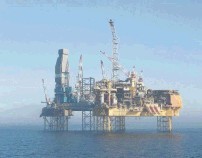
Waiting for the right weather conditions delayed Total’s operation to stop the leak on its Elgin platform.
But once work started, it took just 12 hours to stem the flow of gas which had been pouring out of the G4 well 150 miles off Aberdeen since March 25.
The process was not unusual in itself, but because of the situation – offshore, with gas leaking into the open – it was not simple.
After weeks of careful preparation and waiting for go-ahead from regulators and favourable weather, the “top kill” process started on Tuesday morning, just after 9am.
Drilling mud – a type of heavy fluid twice the weight of water – started to be pumped from the West Phoenix mobile drilling rig via a series of pipelines to the Elgin platform and then down into the well 13,125ft below the surface of the water.
The mud was poured in until the well was completely filled and the substance was circulating back to the top, bringing out any gas and condensate, a petroleum-like substance.
The heavy mud then continued to be circulated around the well until no more gas or condensate was escaping.
That point was reached at about 9pm on Tuesday.
The process was called a dynamic well kill, which meant additional pressure, about 20-30% more than normal, was put on the mud to make sure it reached all parts of the well, creating enough pressure to plug any points where gas might have been getting into the well from beneath the seabed.
About 35,300 cubic feet of the mud was prepared for the operation, from the UK and Norway, and about 16,700 cubic feet of that was actually used.
The mud will continue to be circulated until Friday when a different type of mud, which can be left in the well, will be pumped in.
This will be left while the firm prepares to put staff back on the platform and the Rowan Viking drilling rig will then cement-in the well.